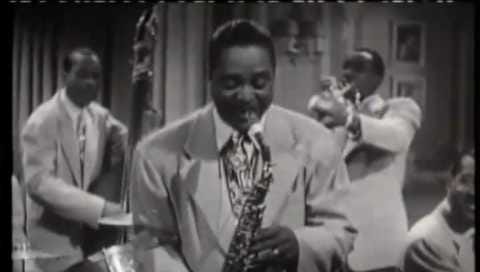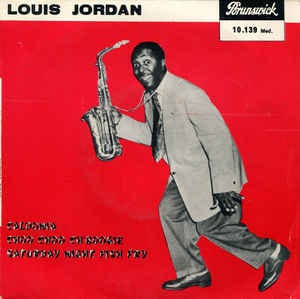"Caldonia" By LOUIS JORDAN & HIS TYMPANY FIVE
I’ll always love you baby ‘cause Caldonia is your name
Louis Jordan was a lot of things — “The King of the Jukebox,” “The King of the Bobbysoxer Brigade,” “The Father of R&B,” The Grandfather of Rock ‘n’ Roll” — but the thing about him that allowed much of that to happen is that he was funny. Humor opened a lot of doors through which he burst with his outsized talent. That elbow in the ribs jostled millions onto the dancefloor.
As for that talent, Jordan was one of two regular singers in the Chick Webb orchestra that, as house band for the Savoy Ballroom, ruled Harlem in the 1930s — the other was Ella Fitzgerald. He could switch between singing and his alto saxophone without (literally) missing a beat. Leading his own band, he had five consecutive #1 singles on the Billboard “Race” charts (later renamed R&B) and 18 overall in the ‘40s, holding the top spot for an astonishing total of 113 weeks, with 54 songs in the top ten. Jordan ruled the charts as both king and kingslayer: He and his Tympany Five bands made the big jazz orchestras nearly obsolete, proving that six could swing as hard and play as loud as 17, for a lot less money. His comedic touch, however, made it a whole lot easier to cross over to white audiences, many of whom discovered his music thanks to Armed Forces Radio and V-disc1 records sent to WWII soldiers, which is why history can sometimes regard him as less a king than a jester.
“Caldonia” was the first non-gospel song Little Richard learned to play. It’s easy to hear the squeaky shriek of Jordan’s “Cal-don-YA! Cal-don-YA!” in Richard’s exuberant vocal style. As kings go, Jordan is like Genghis Khan, in that his genetic material spread far and wide. Chuck Berry copped his signature style not from Marty McFly but from Tympany Five guitarist Carl Hogan, particularly the solo on “Salt Pork, West Virginia” and the intro to “Ain’t That Just Like a Woman.” Jordan was one of James Brown’s biggest influences.2 When Brown met him, he told his idol that he’d probably sung “Caldonia” as many times as he had — it’s where Brown got the idea to not just sing, but put on a show. That’s three inaugural Rock ‘n’ Roll Hall of Fame inductees. From there, consider the influence Berry then had on the formation of pillars like The Beatles and The Rolling Stones and that Brown is arguably the most influential American musician of the 20th Century3. Popular music’s 23andMe is shot through with Louis (“Lew-ee,” like the French kings) Jordan.
“Caldonia” was originally “Caldonia Boogie” and had been recorded by Woody Herman and Erskine Hawkins before Jordan’s label, Decca, got around to releasing his own song in April of 1945. All three versions were hits. The song had been in Jordan’s repertoire since the summer of ‘44, including a performance for Armed Forces Radio broadcast at the end of the year. The song’s up-tempo, driving rhythm and squawking horns pretty much define jump blues, which gave the rollicking Fats Waller-style blues of the ‘20s and ‘30s the force of big band swing. The “jump” of jump blues referenced couples jumping up to get out on the dancefloor. Its irreverent, bawdy lyrics were a tonic for tough times. Nothing about it isn’t fun.
You know, my mama told me to leave Caldonia alone
That's what she told me, no kidding
That's what she said, she says
"Son, keep away from that woman, she ain't no good
Don't bother with her”
But mama didn't know
What Caldonia was putting down
So I'm going down to Caldonia's house
And ask her just one more time
Caldonia!
Caldonia!
What makes your big head so hard?
Mouth
The band, which has been churning like a paddle-wheeler, comes to a dead stop for each Jordan yowl of “Cal-don-YA!” Each tiny pause stops the dancing and builds anticipation. Drummer Razz Mitchell stomps out a beat like a toddler throwing a tantrum, timing a snare hit with each word of “what makes your big head so hard.” The whole band jumps in for a single perfectly timed hit as Jordan — no doubt joined by voices from a full dancefloor — blurts “mouth.” “Caldonia” is a hoot, and its dynamic shifts are a bit of genius. Throw it on a road trip mix and feel your mood lift for a few miles. It’s perfectly ridiculous, done perfectly.
Combining the subtle shifts in accentuation that make music swing with expert comedic timing — that kind of fun is serious business. Jordan’s father James Aaron Jordan was the bandleader for F.M. Wolcott’s Rabbit’s Foot Minstrels, a tent show that traveled the South from the turn of the century to the ‘50s. (Levon Helm described the show and its “Midnight Ramble” in interview portions of The Last Waltz, Martin Scorsese’s film about the last performance by The Band.) Jordan joined the show in his teens. Playing with his father in the Foots and the precise, uniformed Brinkley Brass Band ingrained the work of music in Jordan. The Tympany Five were hot, and players got recruited for other bands all the time, often to later return. Throughout lineup shifts and grind of long bus tours, Jordan still ran the tightest band this side of Basie’s legendary swing machine.
“Caldonia” was also a hit in theatres. Jordan recorded dozens of “soundies,” promotional clips that were precursors to music videos, and filmed two versions of the song for shorts Caldonia and Swing Parade of 1946. Jordan’s appearance is brief in Swing Parade of 1946, which was tailored for white audiences. Caldonia was a two-reel short with four full Jordan songs and a loose, appropriately comedic plot featuring Apollo Theater comedian Sam “Spo-De-O-Dee” Theard. Billboard noted it was “one of the few all-negro productions to get bookings in white theaters.”
The Rock & Roll Hall of Fame inducted Louie Jordan as an “early influence” in 1987, citing “his classic “Saturday Night Fish Fry” is an early example of rap and possibly the first rock and roll recording.” Okay, sure. Jordan’s influence is undeniable; there’s no path to rock ‘n’ roll that doesn’t go through him (see above). The Rock Hall’s distinction, however, seems to echo Rolling Stone’s 1980 article on ‘50s music, which defined Jordan as not rock ‘n’ roll because his music was for adults, and early rock ‘n’ roll was for teenagers. It could just be that distinctly baby boomer perspective, classifying pop culture by whether or not it caters to them, but drawing category lines based on who the music is for, rather than what, misses the point of songs like “Caldonia”: Fun is for everyone. Louis Jordan was an innovator who made millions of people dance and laugh, an act worthy of a king.
28 Song Playlist
Louis Jordan, alternate versions of “Caldonia,” and a whole lot more jump blues. If you’ve read down this far, you can imagine that I’d say it’s fun.
Jump Reds
Lacrima means “tears,” as with “lachrymose.” The skin of this red grape from the Marche region of Italy, halfway up the Adriatic side of the boot, cracks a bit as it matures. Tiny drops of grape juice leak through — so, tears. Lacrima wines are low in tannins and are best enjoy young and often chilled, as is the case with Tenuta San Marcello Lacrima di Morro d'Alba Porpora "Bastaro" 2019, chilled. There’s nothing sad about this bright, friendly red. Violets, roses, and cherries, fresh berries, and spices jump out of the glass. This is so nerdy that I could kiss the mountain biking donkey on the label: 80% is aged in stainless steel and another 20% in clay Georgian vessels called qvevri, which are more neutral than oak barrels but allow for the same kind of micro-oxidation that adds complexity and mouthfeel.
Thank You
This newsletter owes a lot to James McBride’s Kill ‘Em And Leave: Searching for James Brown and the American Soul, both this particular one and The Best Song Ever (This Week) on the whole. McBride’s few sentences on the power and importance of Louie Jordan are better than all mine put together. But I wouldn’t be writing any of this if not for this book. I’ve received approximately all of the books on James Brown and couldn’t really get through them — too much myth, scandal, and scuttlebutt. McBride’s was a Christmas present from a couple years back, but I didn’t read it until this spring. It’s a brilliant, and it sees James Brown as I’d hoped see him, plus a whole, whole lot more. Please give it a read. It also made me think that writing about music could be more than what I was seeing, and that I shouldn’t wait for someone else to do it. (McBride’s busy being a brilliant novelist.)
Thank you,
Scott
V-Disc (“V” for “victory”) was a label formed in 1943 to make and distribute records for U.S. military service members.
One other key influence on James Brown is that he saw his idol’s career fade because he didn’t change, which partly explains the relentless drive the world saw from James Brown.
It’s a fairly easy argument, actually. It’s just not worth gumming up paragraphs on Louis Jordan with big pronouncements that get people needlessly riled up.








